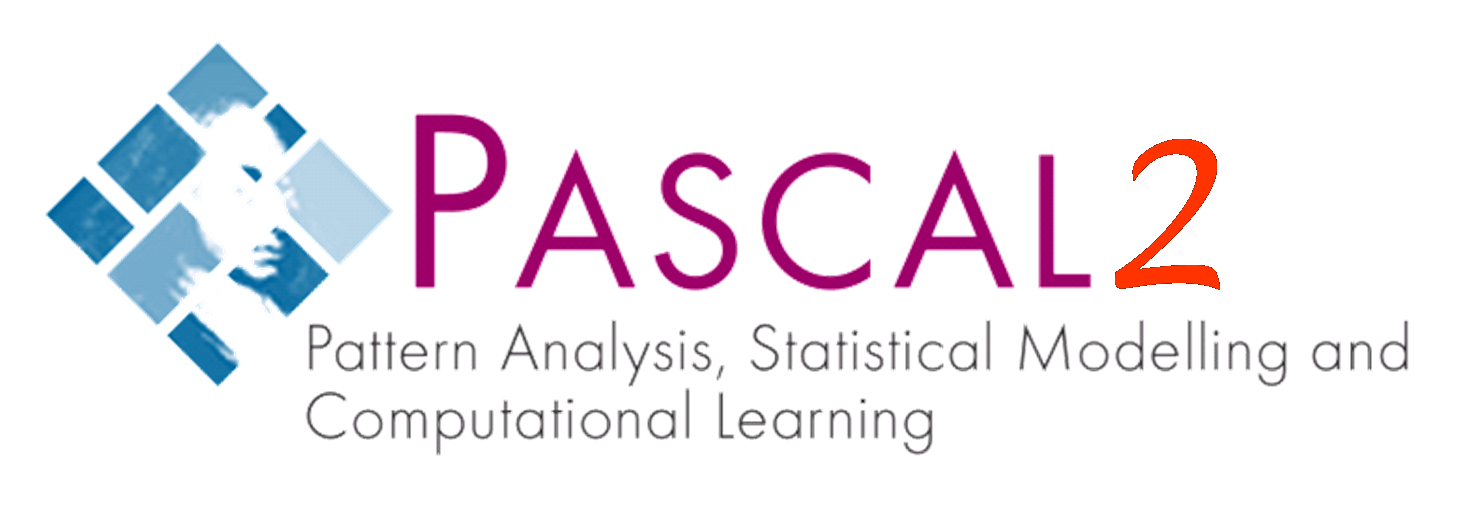

[ goals | news | data sets | schedule | submission | download | organizers | references ]
Data sets 1:
‹motor imagery, uncued classifier application›
(description)
provided by the
Berlin BCI
group:
Technische Universität Berlin
(Machine Learning Laboratory) and
Fraunhofer FIRST (Intelligent Data Analysis Group)
(Klaus-Robert Müller,
Benjamin Blankertz, Carmen Vidaurre, Guido Nolte),
and Campus Benjamin Franklin of the Charité - University Medicine
Berlin, Department of Neurology, Neurophysics Group (Gabriel Curio)
EEG, motor imagery (2 classes of left hand, right hand, foot);
evaluation data is continuous EEG which contains also periods of idle state
[64 EEG channels (0.05-200Hz), 1000Hz sampling rate, 2 classes (+ idle state), 7 subjects]
Data sets 2a:
‹4-class motor imagery›
(description)
provided by the
Institute for Knowledge Discovery
(Laboratory of Brain-Computer Interfaces),
Graz University of Technology,
(Clemens Brunner, Robert Leeb, Gernot Müller-Putz,
Alois Schlögl, Gert Pfurtscheller)
EEG, cued motor imagery (left hand, right hand, feet, tongue)
[22 EEG channels (0.5-100Hz; notch filtered), 3 EOG channels, 250Hz sampling rate, 4 classes, 9 subjects]
Data sets 2b:
‹motor imagery›
(description)
provided by the
Institute for Knowledge Discovery
(Laboratory of Brain-Computer Interfaces),
Graz University of Technology,
(Robert Leeb, Clemens Brunner, Gernot -Müller-Putz,
Alois Schlögl, Gert Pfurtscheller)
EEG, cued motor imagery (left hand, right hand)
[3 bipolar EEG channels (0.5-100Hz; notch filtered), 3 EOG channels, 250Hz sampling rate, 2 classes, 9 subjects]
Data sets 3:
‹hand movement direction in MEG›
(description)
provided by the
Brain
Machine Interfacing Initiative, Albert-Ludwigs-University
Freiburg, the
Bernstein
Center for Computational Neuroscience Freiburg
and the
Institute
of Medical Psychology and Behavioral Neurobiology,
University of Tübingen
(Stephan Waldert,
Carsten Mehring,
HubertPreissl,
Christoph Braun)
The data set contains directionally modulated low-frequency MEG
activity that was recorded while subjects performed wrist movements in
four different directions.
[10 MEG channels (filtered to 0.5-100Hz), 400Hz sampling rate, 4 classes, 2 subjects]
Data sets 4:
‹finger movements in ECoG›
(description)
provided by
Departments of Physics and Medicine of the
University of Washington, Seattle
(Kai J. Miller) and
Wadsworth Center, NYS Department of Health
(Gerwin Schalk)
ECoG data during individual flexions of the five fingers; movements acquired with a data glove.
[48 - 64 ECoG channels (0.15-200Hz), 1000Hz sampling rate, 5 classes, 3 subjects]
July 3rd 2008: launching of the competition
November 21st 2008, midnight CET to Nov 22nd: deadline for
submissions
December 12th 2008: announcement of the results at a
workshop of
NIPS 2008
and on this web site
Submissions to a data set are to be sent to the responsible contact person as stated in the data set description. The submission has to comprise the estimated labels, names and affiliations of all involved researchers and a short note on the involved processing techniques. We send confirmations for each submission we get. If you do not receive a confirmation within 2 days please resend your email with CC to the other organizing committee members, ‹benjamin.blankertz@tu-berlin.de›, ‹alois.schloegl@tugraz.at›, ‹waldert@bccn.uni-freiburg.de›, ‹kjmiller@u.washington.edu›.
One researcher may NOT submit multiple results to one data set. She/he has to decide for her/his favorite one. However: From one research group multiple submissions to one data set are possible. The sets of involved researchers do not have to be disjoint, but (1) the 'first author' (contributor) should be distinct, and (2) approaches should be substantially different.
For details on how to submit your results please refer to the description of the respective data set. If questions remain unanswered send an email to the responsable contact person for the specific data set which is indicated in the description.
Submissions are evaluated for each group of data sets separately. There is no need to submit for all data sets of the competition in order to participate, however each submission must provide results for all data sets of one group (e.g., for all subjects provided in Data sets 2a).
Each participant agrees to deliver an extended description (4-6 pages) of the used algorithm for publication until Februar 1st 2009 in case she/he is the winner for one of the data sets.
[ top ]Each participant has to agree to give reference to the group(s) which recorded the data and to cite (one of) the paper listed in the respective description in each of her/his publications where one of those data sets is analyzed. Furthermore, we request each author to report any publication involving BCI Competiton data sets to us for including it in our list.
[ top ]
Berlin: Benjamin Blankertz, Carmen Vidaurre, Michael Tangermann, Klaus-Robert Müller
Graz: Clemens Brunner, Robert Leeb, Gernot Müller-Putz, Alois Schlögl, Gert Pfurtscheller
Freiburg/Tübingen: Stephan Waldert, Carsten Mehring, Ad Aertsen, Niels Birbaumer
Washington/Albany: Kai J. Miller, Gerwin Schalk
[ top ]The first BCI Competition was announced at NIPS 2001, and the second at NIPS 2002. The first competition was a first try to see how such a thing would work and it was only announced in a smaller community. Accordingly there were not such much submissions, but nevertheless many researchers showed great interest when the results were published (first in the internet and then in IEEE Trans Neural Sys Rehab Eng, 2003, vol 11(2), pp. 184-185 [ draft ]). For the second competition data sets were provided by four of the leading groups in EEG-based BCIs. Here we received 59 submissions. A review of the 2nd competition appeared in IEEE Trans Biomed Eng, 51(6):1044-1051, 2004 [ draft ] and articles of all winning teams of the competition were published in the same issue which provides a good overview of the state of art in classification techniques for BCI. The 3rd BCI Competition involved data sets from five BCI labs and we received 99 submissions. It was reviewed in IEEE Trans Neural Sys Rehab Eng, 14(2):153-159, 2006 [ draft ] and individual articles of the competition winners appeared in different journals.
